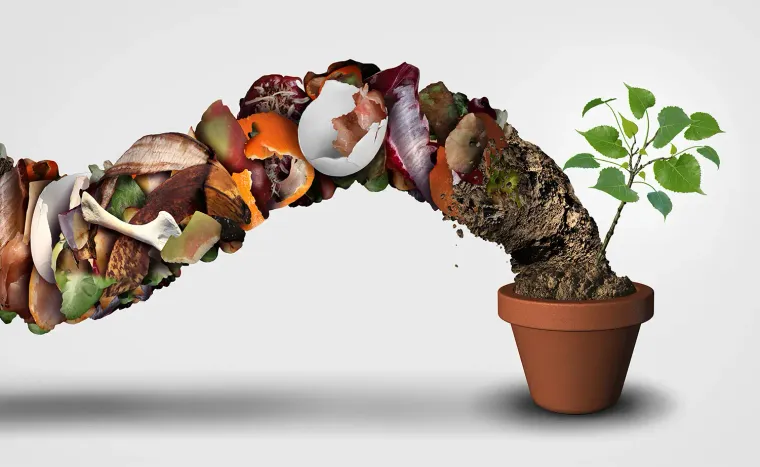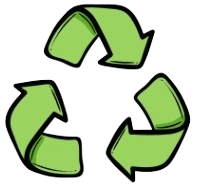* This article was last updated in and is based on extensive research from reputable sources, including scientific studies, government reports, and environmental organizations. For further reading and verification, refer to the sources list.
Introduction
In an era increasingly focused on environmental sustainability, the terms "organic waste" and "biodegradable waste" are frequently used, often interchangeably.
However, while related, these terms represent distinct categories with different implications for waste management and environmental impact.
This article aims to delve into the definitions of organic and biodegradable waste, explore their common sources and examples, compare and contrast their key characteristics, detail their decomposition processes, analyze their environmental impacts, and discuss prevalent waste management practices associated with each.
Curious what counts as biodegradable? See which items make the list and how to dispose of them properly.
Defining Organic Waste
Organic waste is broadly defined as any material that is biodegradable and originates from a plant or animal source [1]. This encompasses a wide array of materials encountered in daily life, from household kitchens to commercial establishments and agricultural activities [2]. Common sources of organic waste include food waste, such as fruit and vegetable scraps, meat, bones, and dairy products [3].
Yard waste, also known as green waste, including grass clippings, leaves, branches, and pruning waste, also falls under the umbrella of organic waste [4].
Additionally, food-soiled paper products like greasy pizza boxes, paper towels, and napkins are considered organic waste [5]. Non-hazardous wood waste, such as untreated and unpainted lumber, coffee stirrers, and toothpicks, is also classified as organic [6].
Even materials like coffee grounds, eggshells, and cut flowers are examples of organic waste [7]. The fundamental characteristic of organic waste is its biological origin, meaning it was once living or part of a living organism [8].
Not all biodegradable items are compostable. Learn the key differences to avoid common misconceptions.
Defining Biodegradable Waste
Biodegradable waste, on the other hand, is defined by its ability to be broken down into simpler substances by microorganisms and other living organisms through natural processes like composting, aerobic digestion, or anaerobic digestion [9].
This breakdown results in byproducts such as carbon dioxide, water, methane, compost, humus, and simple organic molecules [10]. Biodegradable waste primarily includes organic matter, such as kitchen waste (spoiled food, trimmings), plant matter, ash, soil, and manure [11]. However, the definition can sometimes extend to certain inorganic materials that can be decomposed by bacteria, such as gypsum and simple sulfates [12].
Common sources of biodegradable waste overlap significantly with organic waste, including food waste, green waste, paper waste, and some biodegradable plastics [13]. Other examples include human waste, sewage, sewage sludge, and slaughterhouse waste [14]. Natural textiles like cotton and wool are also biodegradable [15].
The key attribute of biodegradable waste is its capacity to decompose naturally, regardless of its origin (plant, animal, or certain inorganic compounds) [16].
Curious about decomposition rates? Discover how long biodegradable trash really takes to break down.
Key Differences Between Organic and Biodegradable Waste
While the terms are closely related, the primary distinction lies in the scope and the defining characteristic. Organic waste is defined by its source—it must come from plant or animal matter and be biodegradable [17]. Biodegradable waste is defined by its property—it must be capable of being decomposed by biological processes [18].
Therefore, all organic waste is biodegradable, but not all biodegradable waste is necessarily organic in the strict sense of originating solely from plants or animals (e.g., some biodegradable plastics or certain inorganic compounds) [19].
Furthermore, the term "biodegradable" lacks a specific timeframe for decomposition, meaning a material could technically break down over a very long period and still be considered biodegradable [20].
In contrast, the concept of "compostable" is often used to describe organic materials that break down within a specific timeframe under defined conditions to produce nutrient-rich compost [21].
Learn more about the environmental benefits of biodegradable trash and why it matters.
Decomposition Processes
The decomposition processes for both organic and biodegradable waste rely heavily on the activity of microorganisms such as bacteria and fungi [22]. These microorganisms secrete enzymes that break down complex organic molecules into simpler compounds [23].
The decomposition can occur through two primary pathways: aerobic (in the presence of oxygen) and anaerobic (in the absence of oxygen) [24]. Aerobic decomposition, prevalent in composting, involves microorganisms that use oxygen to break down organic matter, producing carbon dioxide, water, heat, and nutrient-rich compost [25].
This process typically involves different phases with varying temperature ranges, supporting the activity of mesophilic (moderate temperature) and thermophilic (high temperature) microorganisms [26].
Anaerobic decomposition, which occurs in environments lacking oxygen such as landfills or anaerobic digesters, results in the production of methane, carbon dioxide, and digestate (a slurry-like byproduct) [27].
Discover how biodegradable trash breaks down compared to regular waste and what it means for the environment.
Timeframe for Degradation
The timeframe for the degradation of both organic and biodegradable waste varies significantly depending on factors such as the type of material, the presence of oxygen, temperature, and moisture levels [28]. For instance, food scraps and yard trimmings can decompose relatively quickly in a well-managed compost pile within weeks to months [29].
Paper products also tend to decompose within a few months under favorable conditions [30]. However, in the anaerobic conditions of a landfill, the decomposition rate can be much slower, with some organic materials taking decades to break down [31].
Biodegradable plastics, while designed to break down more readily than conventional plastics, can still take months to years depending on the specific type and the environment [32].
Some materials, even if biodegradable, may persist for extended periods in landfills due to the lack of necessary conditions like oxygen and moisture [33].
Explore the types, benefits, and challenges of biodegradable trash in this comprehensive guide.
Environmental Impact
The environmental impact of organic and biodegradable waste is a significant concern. When organic waste decomposes anaerobically in landfills, it produces methane, a potent greenhouse gas that contributes significantly to climate change [34].
Organic waste in landfills is a major source of methane emissions [35]. However, when managed properly through composting or anaerobic digestion, organic waste can be transformed into valuable resources like compost, which improves soil health and reduces the need for chemical fertilizers [36].
Anaerobic digestion of organic waste can also produce biogas, a renewable energy source [37]. Biodegradable waste, by its nature, is intended to reduce the long-term environmental burden associated with non-degradable waste [38].
However, the environmental benefits of biodegradable products depend on their proper disposal. If biodegradable items end up in landfills, they may still contribute to methane emissions under anaerobic conditions [39].
Furthermore, some biodegradable materials might not break down effectively in home composting systems and may require industrial composting facilities to degrade properly [40].
Waste Management Practices
Common waste management practices for organic waste prioritize diverting it from landfills. Composting is a widely used method, both at household and industrial scales, to aerobically decompose organic waste into a valuable soil amendment [41].
Anaerobic digestion is another effective method for managing organic waste, particularly food waste and manure, where it is broken down in the absence of oxygen to produce biogas and digestate [42].
Some jurisdictions have implemented mandatory organic waste recycling programs for businesses and multi-family properties to reduce landfill waste and greenhouse gas emissions [43].
For biodegradable waste, management practices include industrial composting, which provides controlled conditions for faster and more complete degradation of materials like biodegradable plastics [44]. Biodegradation can also occur in landfills, although the anaerobic conditions often lead to slower decomposition and methane production [45].
Certifications and Standards
Certifications and standards play a crucial role in distinguishing truly biodegradable products from those that may not offer significant environmental benefits.
Organizations like the Biodegradable Products Institute (BPI) and TÜV AUSTRIA offer certifications for compostable products that meet specific criteria for biodegradability within defined timeframes in commercial or home composting environments [46].
These standards ensure that the products break down completely without leaving harmful residues [47]. It is important to note that the natural decomposition of organic materials, while inherently biodegradable, does not always adhere to the same strict standards and timeframes as certified compostable products [48].
The term "biodegradable" itself is often unregulated and can be misleading, as it does not specify the time required for decomposition or the environmental conditions needed [49].
Therefore, certifications provide a more reliable indicator of a product's ability to break down effectively and safely in a composting system [50].
Conclusion
In conclusion, while organic waste and biodegradable waste share the fundamental characteristic of being decomposable by natural processes, they are not entirely synonymous. Organic waste is defined by its biological origin from plants or animals, while biodegradable waste is defined by its ability to be broken down by microorganisms, regardless of its origin.
All organic waste is biodegradable, but the reverse is not always true. Understanding this distinction is essential for effective waste management. Proper management of both organic and biodegradable waste, through methods like composting and anaerobic digestion, is crucial for mitigating environmental impacts such as methane emissions and for recovering valuable resources.
Certifications for compostable products offer a reliable way to identify materials that will break down effectively within specific timeframes and conditions, helping to avoid the ambiguity often associated with the term "biodegradable." By recognizing the differences and implementing appropriate waste management strategies, we can move towards a more sustainable and environmentally responsible approach to handling our waste.
References
https://www.cityofsignalhill.org/DocumentCenter/View/4118/organic-recycling?bidId ↩︎
https://www.repsol.com/en/energy-and-the-future/future-of-the-world/organic-waste/index.cshtml ↩︎
https://www.cityofsignalhill.org/DocumentCenter/View/4118/organic-recycling?bidId ↩︎
https://millerrecycling.com/organic-waste-and-how-to-handle-it/ ↩︎
https://www.peacecorps.gov/educators-and-students/educators/resources/trash-corners-organic-inorganic-or-toxic/ ↩︎
https://byjus.com/chemistry/biodegradable-and-non-biodegradable/ ↩︎
https://www.geeksforgeeks.org/biodegradable-and-non-biodegradable/ ↩︎
https://shapiroe.com/blog/biodegradable-waste-vs-non-biodegradable/ ↩︎
https://byjus.com/chemistry/biodegradable-and-non-biodegradable/ ↩︎
https://www.cityofsignalhill.org/DocumentCenter/View/4118/organic-recycling?bidId ↩︎
https://byjus.com/chemistry/biodegradable-and-non-biodegradable/ ↩︎
https://bokashiorganko.com/bokashi-library/biodegradable-waste ↩︎
https://aggie-horticulture.tamu.edu/earthkind/landscape/dont-bag-it/chapter-1-the-decomposition-process/ ↩︎
https://burcellteam.com/articles/how-do-organic-materials-of-solid-waste-decompose-naturally/#:~:text=Microorganisms%2C like bacteria and fungi,transforming it into simpler substances ↩︎
https://aggie-horticulture.tamu.edu/earthkind/landscape/dont-bag-it/chapter-1-the-decomposition-process/ ↩︎
https://aggie-horticulture.tamu.edu/earthkind/landscape/dont-bag-it/chapter-1-the-decomposition-process/ ↩︎
https://aggie-horticulture.tamu.edu/earthkind/landscape/dont-bag-it/chapter-1-the-decomposition-process/ ↩︎
https://www.repsol.com/en/energy-and-the-future/future-of-the-world/organic-waste/index.cshtml ↩︎
https://www.rts.com/blog/how-long-does-it-take-for-common-materials-to-decompose/ ↩︎
https://recyclops.com/how-long-does-it-take-to-decompose/ ↩︎
https://recyclops.com/how-long-does-it-take-to-decompose/ ↩︎
https://recyclops.com/how-long-does-it-take-to-decompose/ ↩︎
https://packlane.com/blog/how-long-do-biodegradable-packaging-decompose ↩︎
https://recyclops.com/how-long-does-it-take-to-decompose/ ↩︎
https://www.cityofsignalhill.org/DocumentCenter/View/4118/organic-recycling?bidId ↩︎
https://www.epa.gov/lmop/basic-information-about-landfill-gas ↩︎
https://www.repsol.com/en/energy-and-the-future/future-of-the-world/organic-waste/index.cshtml ↩︎
https://recyclops.com/how-long-does-it-take-to-decompose/ ↩︎
https://www.zerowaste.com/blog/biodegradable-vs-compostable-whats-the-difference/ ↩︎
https://www.fairfaxcounty.gov/publicworks/recycling-trash/composting-and-more ↩︎
https://www.repsol.com/en/energy-and-the-future/future-of-the-world/organic-waste/index.cshtml ↩︎
https://www.cityofsignalhill.org/DocumentCenter/View/4118/organic-recycling?bidId ↩︎
https://www.cityofsignalhill.org/DocumentCenter/View/4118/organic-recycling?bidId ↩︎
https://www.goodstartpackaging.com/biodegradable-vs-compostable-what-is-the-difference/ ↩︎
https://www.goodstartpackaging.com/biodegradable-vs-compostable-what-is-the-difference/ ↩︎
https://www.goodstartpackaging.com/biodegradable-vs-compostable-what-is-the-difference/ ↩︎
https://www.goodstartpackaging.com/biodegradable-vs-compostable-what-is-the-difference/ ↩︎


